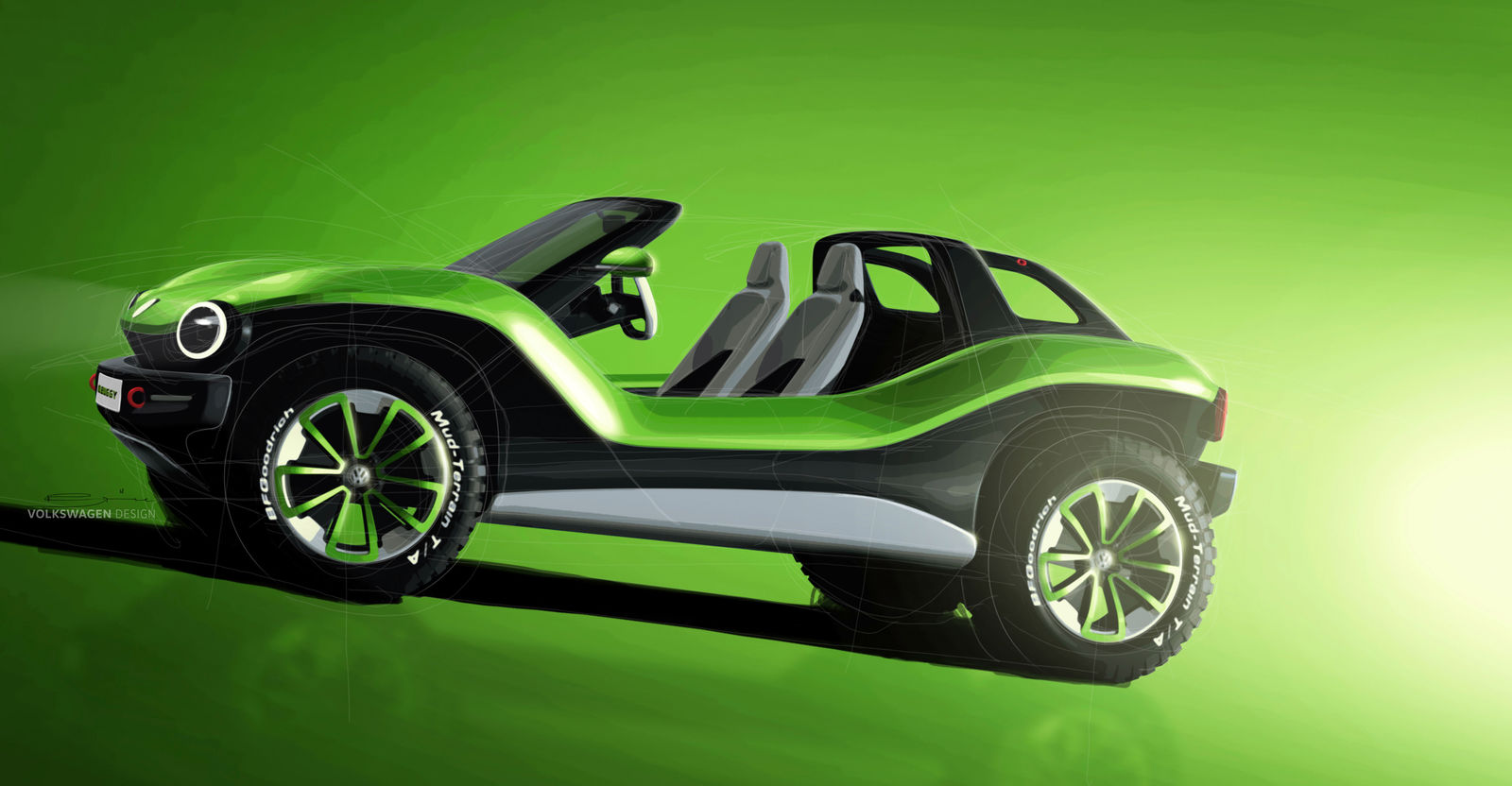Firm proportions. The ID. BUGGY was designed for driving over unpaved tracks, dunes and beaches. You can see it on every millimetre and from every perspective. But of course, this Volkswagen is also predestined for warm evenings in the city. “Summer in the City” – live and via Bluetooth speaker. The driver and front passenger observe the striking raised wings; in the middle of the vehicle, the lowered sill panel openings continue the line of the wings; in the rear-view mirrors, the shoulder of the rear end rises up high. The surrounding line of free-standing wings, sill panel openings, raised front bonnet and an even higher rear end – painted in a matt but radiant Fern Green – surrounds the car. The area below – also surrounding the car – is in dark Grey Tech Blue, a textured paint. The effect of these two colours is brilliant: It allows the green part to visually float above the dark blue area. This is new and light – but still pure Buggy, pure ID. The open zero-emission concept car is 4,063 mm long, 1,890 mm wide and 1,463 mm high. Quite short are the front (686 mm) and rear (727 mm) overhang. The wheelbase between the axles is 2,650 mm.
Friendly front end. Volkswagen is one of the few car manufacturers whose vehicles’ brand association can be immediately identified even without a classic radiator grille. This is because the design is genetically traced back to the Beetle and Transporter. Cars without any kind of radiator grille. They didn’t need it with their air-cooled rear engines. The same is true for the ID. Family. Because their electric motors do not need an airstream. This also characterises the front end of the ID. BUGGY – a completely new vehicle immediately recognisable as a Volkswagen. This conciseness of design also makes the ID. BUGGY unique. And more than that: With this concept car, the team headed by Klaus Bischoff created a completely new approach for a summer cruiser. The surrounding line of the front bonnet actually seems to float above the massive bumper. The same is true for the three-dimensional LED headlamps with their oval daytime running light and pupil-like dipped and main beams. Visually, there is the impression that the LED ovals also float freely and are only firmly connected to the car in the area of the front bonnet. The VW logo on the bonnet is also designed as an LED element. Two red, robust steel eyelets are integrated in the bumpers to rescue other vehicles or the ID. BUGGY itself, if it can no longer drive. LED turn signals are integrated in the side and top of the rear-view mirror caps. All the details together make up the friendly, confident face of a new all-terrain vehicle. Last but not least, a solid aluminium underbody guard ensures that the front axle and ancillaries are not damaged during off-road driving.
Floating silhouette. In the same way as the front bonnet, the top side section of the body seems to float. With its distinctive character line, it runs above the 18-inch wheels and off-road tyres (255/55 BFGoodrich at front and 285/60 BFGoodrich at rearÒ All Terrain T/A). In the area of the sill, this line drops and rises again at the rear. The side sill panel runs parallel to it. At the same time, it assumes the function of an additional underbody guard; here, too, the choice of material was aluminium (coated with a chrome effect paint). Ground clearance under the axles is 240 mm. Everything is cleanly and yet emotionally designed. A few lines that create a must-have feeling. In the centre, the open silhouette provides a view of the backrests of the integral seats and the multifunctional ID. steering wheel. The roof frames are in Grey Tech Blue. The reinforced windscreen frame together with the Targa bar, which is also open at the side, provides rollover support. There is no roof in the classic sense. However, a black tarpaulin can be stretched between the windscreen frame and the Targa bar as a sun sail or light weather protection.
Powerful rear end. The rear end is very high and wide – typical for a buggy. It looks clean and cool, light and yet robust. Here, too, the surrounding character line continues. Painted in Fern Green, the upper section of the rear seems to float above the lower dark blue section. Just like the LED headlights at the front end, the three-dimensional LED tail light clusters at the rear have an oval design. The outer rim is integrated in the area painted in the car colour at the top – the effect of which is that the lower 60 per cent visually floats above the black body level. The interface for battery charging is located underneath the illuminated VW logo at the rear. A solid bumper cross beam runs below it – also fitted with red eyelets as an attachment point for ropes. Next to it are the LED turn signals. Finally, on the lowest level there is another aluminium underbody guard.
